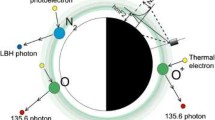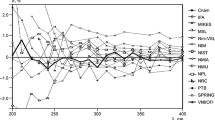Abstract
THE visible spectrum of light emitted from a sample of polonium has been photographed using the night-sky spectrograph designed by McLennan and Ireton1. The activity of the sample was about 4 mC., and it was deposited on a platinum sheet, 3 mm. × 3 mm. This shape was chosen for another purpose and is not very suitable for a spectral investigation. The night-sky spectrograph contains a glass prism and, therefore, its application is restricted to the visible range. The aperture is f/l. The slit-width used in this investigation was 0.4 mm. The polonium sample was put in two positions with respect to the slit of the spectroscope: (1) the surface of the sample was in the plane of the slit parallel to the collimator axis so that light emitted from the surface could enter the slit; (2) the surface was about 1 mm. below the slit, so that only light emitted from the volume of ionized gas (air) above the surface could enter the slit.
Similar content being viewed by others
References
McLennan and Ireton, Proc. Roy. Soc., A, 129, 31 (1930).
Kayser, H., “Tabelle der Hauptlinien der Linienspektren aller Elemente” (Berlin, 1926).
Author information
Authors and Affiliations
Rights and permissions
About this article
Cite this article
ORTNER, G., SALIM, S. Light Emission from Polonium. Nature 169, 1060–1061 (1952). https://doi.org/10.1038/1691060b0
Issue Date:
DOI: https://doi.org/10.1038/1691060b0
- Springer Nature Limited
This article is cited by
-
Luminescence produced in Air by Polonium-210 α-Particles
Nature (1957)
-
Cathodoluminescence of Air, Quartz and Metal Films
Nature (1954)
-
Radiation induced by Alpha-Particles in Thin Films
Nature (1953)





